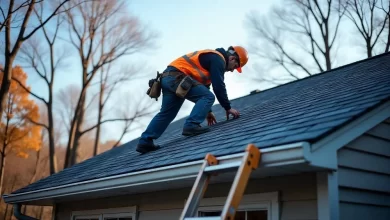Can You Put Rolled Roofing Over Old Rolled Roofing?

Have you noticed your existing rolled roofing showing signs of wear and tear? Before you decide to completely tear it off and install new roofing, find out if you can simply install new rolled roofing over the old roof. This option can save you time, effort, and money compared to a full roof replacement.
Rolled roofing, also known as tar paper roofing, is an asphalt-based material used to waterproof roofs. It comes in rolls of 3-4 feet wide that are installed overlapping each other and nailed to the roof deck.
What is Rolled Roofing?
Rolled roofing material consists of an asphalt-saturated carrier sheet, covered with asphalt and mineral granules on the outer surface. The asphalt makes it waterproof, while the mineral granules protect from ultraviolet radiation. Here are some key features of rolled roofing:
- Carrier sheet material – Fiberglass mat or organic felt paper
- Weight – Typically 45 to 90 pounds per roll
- Surface finish – Mineral granules that resemble shingles
- Easy to transport and work with
- Can be used for low-slope roofs or as an underlayment
- Types include smooth and mineral-surfaced roll roofing
Advantages of Rolled Roofing
- Low material and installation cost
- Quick and easy installation
- Can be installed over existing roofing
- Long service life up to 20 years
- A wide variety of colors and surface finishes are available
Disadvantages of Rolled Roofing
- Susceptible to leaks over time
- Not suitable for high slopes or steep roofs
- Prone to damage from falling objects
- Reflective mineral granules can loosen over time
- Not as aesthetic looking as shingles or metal roofing
Overall, rolled roofing provides an affordable and practical roofing solution, especially for flat or low-pitched roofs.
II. Application of Rolled Roofing
Rolled roofing is commonly used in residential homes, apartment buildings, sheds, garages, porches, and more. The flat or gently sloping roofs found on these structures are ideal for applying rolled roofing.
It can be used as the primary roofing material directly fastened to the roof deck. Alternatively, it can serve as an underlayment beneath shingles, metal roofing, or tiles. The underlayment provides an added weather-resistant barrier.
When compared to other popular roofing options:
- Asphalt Shingles – More aesthetically pleasing than rolled roofing but requires a steeper roof pitch. Shingles are more expensive but with a comparable lifespan.
- Metal Roofing – Long lasting but higher upfront cost. Difficult for do-it-yourself projects due to custom sizing and specialty tools needed.
- Flat Roofs – Rolled roofing is well-suited and a common choice for flat commercial roofs along with PVC, TPO, and EPDM rubber roof membranes.
For sloped roofs greater than 2:12 pitch, shingles or metal panels would be better options. Rolled roofing shines on low-slope residential structures that have limited visibility.
III. Installing Rolled Roofing Over Old Rolled Roofing
Adding new layers of rolled roofing over worn-out existing roofing is possible in many cases. This saves the time and expense required to tear off and dispose of the original roofing. However, there are some important factors to consider before deciding if a roof-over is appropriate.
Is a Roof-Over Feasible?
- The roof structure must be in good structural condition without any leaks or rotting deck boards.
- No more than 2 existing layers of roofing can be safely overlaid with new material.
- The roof slope and drainage must be adequate to prevent ponding water.
- The existing roof surface should be swept clean and made free of any debris or protruding nails.
If major repairs are needed or significant water damage exists, a complete tear-off would be the recommended approach before installing new rolled roofing.
Steps for Installing Rolled Roofing Over Existing Roof
1. Inspect and Prep the Roof
Thoroughly inspect the roof and make any necessary repairs to the deck and flashing. Sweep away loose granules and debris.
2. Install Drip Edge
Apply drip-edge metal flashing along the roof perimeter and protrusions.
3. Fasten Underlayment
Roll out leak barrier underlayment and fasten with roofing nails.
4. Install New Rolled Roofing
Roll out the new rolled roofing from bottom to top with 4-6” horizontal and 6-12” vertical overlaps. Fasten with roofing nails approximately every 18-24”.
5. Apply Sealant
Seal all seams and exposed nail heads with asphalt roof cement. Highly recommended for optimal leak resistance.
6. Terminate at Roof Edges
Tuck the top edge up underneath the drip edge or fascia metal.
Following proper protocols for surface prep, underlayment, and sealing will provide the best roof performance. Taking shortcuts often leads to leaks or wind damage down the road.
Tips and Best Practices
- Always start install at the lowest point to prevent reverse laps
- Use heavier 90 lb. mineral surfaced roll roofing
- The stagger end overlaps each consecutive row
- Fasten underlayment and roofing with 1-1⁄2” nails or metal caps
- Check local building codes for requirements in your area
IV. Maintenance and Durability
Like any roofing system, some basic maintenance and care are required to maximize the lifespan of rolled roofing. Paying attention to the following areas will enhance durability:
Routine Inspections
- Inspect for loose, damaged, or missing shingles after severe weather events
- Clear debris and leaves from the roof at least twice per year
- Check flashings, seals, and nails/fasteners for any needed repairs
- Look for sagging areas that indicate underlying water damage
Preventative Care
- Trimming overhanging tree branches eliminates falling debris
- Installing gutter guards reduces clogged drains and overflow
- Sealing joints, seams, and protrusions maintains water tightness
- Replacing loose aggregate granules reduces UV damage
When properly installed and cared for, how long rolled roofing lasts greatly depends on the climate and weather exposures in your region. Lifespans typically fall within the following ranges:
- Fiberglass Rolled Roofing – 12-20 years
- Organic Felt Rolled Roofing – 5-15 years
Roofing installed over existing materials tends to underperform compared to new applications over bare decking or underlayment. You can expect 10-15 years from fiberglass rolled roofing installed over worn rolled roofing or smooth surface mod bit. Plan on budgeting for replacement or recoating within that timeframe.
V. Safety and Environmental Considerations
Working on rooftops poses obvious risks of falls and injuries. Here are some key safety guidelines when applying rolled roofing:
- Use fall protection equipment and tie off to the roof
- Wear shoes with slip-resistant soles
- Work with a partner to monitor the situation
- Avoid working on wet, icy, or windy days
- Hydrate and take breaks to avoid heat exhaustion
Demolishing and disposing of old roofing does negatively impact the environment. Landfills are filled with an estimated 11 million tons of roofing tear-off waste per year in North America.
Installing new rolled roofing over existing materials greatly reduces this environmental impact. It also minimizes exposure to potential asbestos often found in older built-up roofs. Always inspect roof cores and employ proper asbestos removal protocols when tearing off existing roof systems.
VI. Cost and ROI Analysis
Let’s compare the upfront and lifecycle costs along with the return on investment from installing new rolled roofing over existing versus a complete tear-off.
| Comparison Factors | New Over Old Roof | Complete Tear-off |
|---|---|---|
| Material Cost | $100-150 per square | $100-150 per square |
| Labor Time | 2-3 hours per square | 4-6 hours per square |
| Total Install Cost | $350-450 per square | $600-900 per square |
| Lifespan | 10-15 years | 15-20 years |
| ROI Analysis | – Saves 35% on install cost – Needs replacing 5-10 years sooner | – Higher upfront cost – Longest lifespan |
Based on average roofing contractor costs, installing new rolled roofing over existing roofing saves approximately 35% compared to a full tear-off. However, the new roof will likely need to be replaced 5-10 years sooner than a roof applied to bare decking.
Cost per Year Analysis
- New Over Old Roof – $35-45 per square per year
- Complete Tear-off – $30-60 per square per year
The annualized cost over the roof lifetime comes out fairly comparable. Other factors like structural issues, leaks, and roof traffic may influence whether starting fresh with a tear-off provides better long-term value.
In summary, adding new rolled roofing over worn existing materials makes economic sense in many scenarios. It provides a nice halfway option between patching small sections and a major roof replacement project.
VII. Case Studies and Expert Opinions
Let’s examine some real-world examples along with professional recommendations on installing rolled roofing over existing materials:
Case Study #1
Mitch K. from Florida needed to re-roof his single-story rental home that still had the original rolled roofing installed over 20 years ago. He decided to have a new fiberglass smooth roll installed over the existing organic base sheets rather than spend money on a complete tear-off.
“I chose to overlay because the property inspector confirmed the roof deck was solid. The roofer installed a peel-and-stick ice barrier underlayment for added leak prevention. It’s been 5 years now and the new rolled roofing still looks and performs great.”
Case Study #2
Lynette S. from Oklahoma had problems with her shingled roof leaking around the chimney. The roofer recommended installing new rolled roofing with mineral surface granules from the rake edge to the ridge vent, spanning the entire chimney. This provided an affordable repair option compared to replacing warped deck boards and shingles.
“They roofed over the shingles with new rolled roofing about 10 feet wide all around the chimney. It solved the leaking issue and I didn’t need to spend $2000-3000 to replace the entire roof. I’ll just plan on having them re-roof the whole house in about 10 years.”
Roofer’s Perspective
Veteran roofer foreman Roy G. provides this take:
“I’m fine with roofing over existing rolled roofing as long as the structure is sound. We limit it to no more than two existing layers. I insist on installing peel-and-stick underlayment beneath the new rolled materials now for reliability. Masking off leaks by just overlaying is asking for headaches down the road.”
Roy brings up a good point that the condition of the underlying boards and deck determines if a roof overlay is wise or just delaying inevitable repairs.
Manufacturer’s Stance
Leading rolled roofing brand CertainTeed states:
“Installing new rolled roofing over existing rolled roofing is an acceptable practice as long as roof slope and deck conditions permit, and local building codes allow it. Always follow our application guidelines and utilize midweight or heavyweight rolled products for best moisture shedding performance and durability.”
So the manufacturer confirms that installing new over old is approved in their system warranties. Like any manufacturer though, they want trained contractors following proper protocols to ensure positive roofing outcomes.
VIII. Conclusion
Installing new rolled roofing over existing worn-out roofing offers a convenient method to renew flat or low-slope roofs. It provides significant cost savings compared to full tear-off and new construction. Labor time is also reduced by avoiding time-consuming demolition and debris removal.
The roof-over approach is feasible as long as:
- No more than two roofing layers exist
- The deck and structure are sound
- Proper surface prep and underlayment installation are followed
While lifespan may be decreased by 5-10 years compared to new applications onto bare decking, the upfront savings often warrant consideration of the roof-over method.
Key steps to long-term success:
- Careful assessment of current roof condition and repairs needed
- Strict adherence to manufacturer requirements
- Robust underlayment and generous sealing/nailing
- Periodic maintenance and inspections
- Planning for re-application in 10-15 years
Addressing problems early, preventing accelerated wear, and proper installation will optimize cost-efficiency when you need to upgrade the roof of your existing building.



